Massive Fire Claims Adler and Sulllivan's 1887 Wirt Dexter Building (original) (raw)
Chicago's dwindling roster of Adler and Sullivan landmarks was reduced again on Tuesday as a massive fire destroyed the 1887 Wirt Dexter building on south Wabash Avenue.The fire came little more than 10 months after another blaze gutted the firm's 1891 K.A.M./Pilgrim Baptist Church to the bare 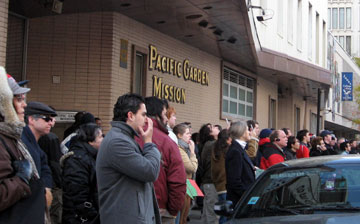 walls.
walls.
A building that had been largely forgotten suddenly became the focus of attention as throngs of spectators watched the spectacular fire from outside the Pacific Garden Mission just across the street. Smoke billowed into huge clouds rising high above the building and seeped through South Loop streets, casting them into an acrid fog that moved up Wabash, through the block-long arcade of Adler and Sullivan's Auditorium Building, and, crossing Michigan Avenue, hung over the gleaming metallic forms of Frank Gehry's Pritzker Pavilion at Millennium Park. In its dying, an essential landmark that in life could find no one to pay it heed, blanketed the city's center with the pain of its demise.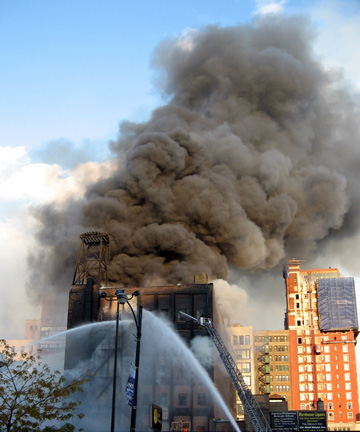
Although it had received official designation in July of 1996, the Wirt Dexter building was the landmark that nobody wanted. "As far as we know, the building was vacant," Fire Commissioner Raymond Orozco said on the scene. Concern continued that the large sign for the long-closed George Diamond steakhouse, the building's last major tenant, would break off the building's Wabash Avenue facade and crash down into the street. The restaurant, a prime venue in the 50's and 60's, underwent a long decline that paralleled that of the area around in it, ending up a threadbare ghost of its former self.
Recently, Chicago's South Loop has been undergoing a major revival, with a massive new dorm for the district's burgeoning student population opening just to the north. Columbia College has been acquiring and renovating vintage turn-of-the-twentieth-century buildings all along the street. The Wirt Dexter, however, continued to be passed by.
The Wirt Dexter was designed by Louis Sullivan and Danker Adler and built in 1887 at a cost of $100,000 as the store and warehouse for furniture manufacturers R. 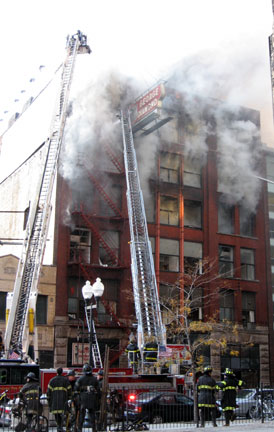 Deimel & Brothers. Unlike the huge Auditorium Building just a few blocks to the north, where Sullivan's design still bears the heavy imprint of Henry Hobson Richardson's Romanesque modernism, the Wirt Dexter, according to biographer Hugh Morrison "show's no trace of Richardson's influence, nor of the characteristic leaf- ornament" that would become integral to Sullivan's work in such buildings as the Carson Pirie Scott store. "It is an entirely mature work," says Morrison, "rigorously thought through," where Sullivan "attained a new simplicity and monumentality growing directly out of the problems of the commercial office building."
Deimel & Brothers. Unlike the huge Auditorium Building just a few blocks to the north, where Sullivan's design still bears the heavy imprint of Henry Hobson Richardson's Romanesque modernism, the Wirt Dexter, according to biographer Hugh Morrison "show's no trace of Richardson's influence, nor of the characteristic leaf- ornament" that would become integral to Sullivan's work in such buildings as the Carson Pirie Scott store. "It is an entirely mature work," says Morrison, "rigorously thought through," where Sullivan "attained a new simplicity and monumentality growing directly out of the problems of the commercial office building."
The entry level is of sparingly ornamented rusticated granite. The brick facade above is arranged into three simple vertical piers, two windows wide at each end, with a three-window-wide bay between them, slightly recessed and originally terminated in a small gable at the roofline. The openness and lightness of the facade, in the judgment of another biographer, Robert Twombly "anticipated the aesthetics of the steel frame." Perhaps the structure's most striking feature, visible along the El that went up a decade later in the alley behind it, is the series of tall, perforated iron support beams, placed outside the building to free up space in the interior, perhaps modern architecture's first example of an exoskeleton.
striking feature, visible along the El that went up a decade later in the alley behind it, is the series of tall, perforated iron support beams, placed outside the building to free up space in the interior, perhaps modern architecture's first example of an exoskeleton.
It's still too early to assess the building's final fate, but the outlook is bleak. Early in the blaze, firefighters were pulled from the interior, back to "defensive" positions pouring thousands of gallons of water onto the building from a half-dozen snorkels, when the spread of the fire throughout the interior made the integrity of the building and of its floors and ceilings uncertain.
The Wirt Dexter's proximity to the El line may speed its doom. Service on the busy Green and Orange lines was shut down just before rush hour, and Chicago Transit Authority President Frank Kreusi told reporters it wouldn't resume until the threat to the tracks was removed, either when the building is again declared structurally sound, or when it "is no longer there." There was speculation that those perforated iron beams were all that was stopping the rear wall from collapsing onto the rails.
The fire raised questions about how the city deals with its most endangered landmarks. There are basically two primary categories of peril for landmark quality buildings. The first comes when a lot of money could be made by knocking them down and replacing them with something else. The second comes when a building, such as the Wirt 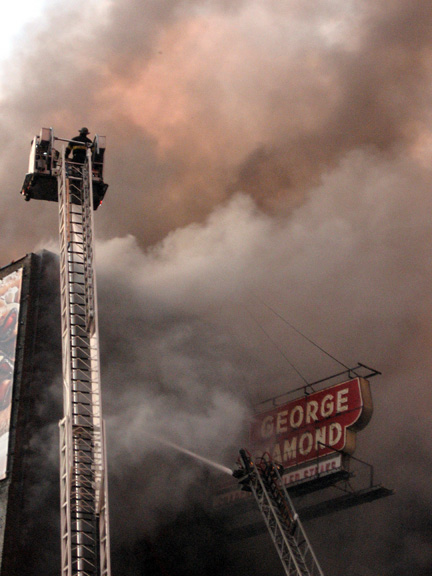 Dexter, is orphaned or abandoned.
Dexter, is orphaned or abandoned.
"My biggest fear," says Mike Moran, Vice President of Preservation Chicago, "is that this is not the last time that we are going to see a major historic building go up in smoke.The Wirt-Dexter Building fire did not have to happen. This fire likely could have been prevented with adequate monitoring by the City."
Just like at Pilgrim Baptist, indications are pointing to the improper use of an acetylene torch as the source of the fire.
"The city must draft a new ordinance, " says Moran, "that mandates better fire protection when certain equipment, such as a blowtorch, is used. There has to be additional personel standing by and additional fire extinguishers at the ready. There needs to be an ordinance that protects these landmark buildngs from these needless fires."
"Clearly," adds Moran, "the system is broken. If the city's current level of monitoring is allowed to stand, then we will eventually be sweeping up the ashes of other historic buildings."
Which way will Mayor Richard M. Daley respond to the fire. Will it be his patented, Rumsfieldian shrug of the shoulders response that "these things happen," or will it be the kind of the passion, commitment and eloquence he can bring to the fore when he feels an issue is vital to the city's interests?
As I've written before, the city needs to help create a public-private partnership that can subsidize the protection of those essential Chicago landmarks that are all but abandoned while awaiting a new use. More and more of the city is being covered by Tax-Increment-Financing districts, which divert increases in tax revenues to encourage economic development. The minimal protection of neglected city landmarks - sealing them up to arrest deterioration and providing the kind of ongoing monitoring that Moran 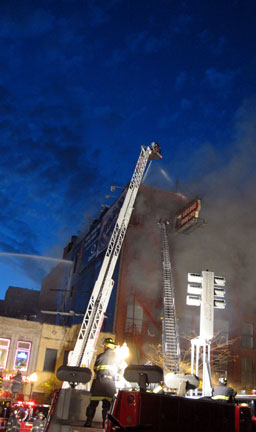 suggests - should be an integral part of that TIF process.
suggests - should be an integral part of that TIF process.
In the words of the city's own landmarks website, the Wirt Dexter was an "irreplaceable link in the chain of work of one of the nation's most important architectural partnerships ." It's buildings like the Wirt Dexter that are the repository of Chicago's character. Tolerating the kind of neglect that made Tuesday's fire possible is a kind of civic suicide.
An October 26th postscript - the Chicago Tribune's sad tale of the Wirt Dexter's owner and her efforts to save the landmark.


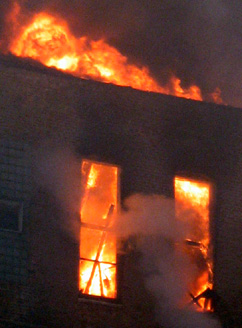
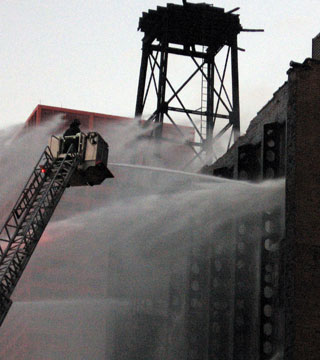

Join a discussion on this story.
© Copyright 2006 images and text Lynn Becker All rights reserved.